Cadillac CTS 2015 Owner's Manual
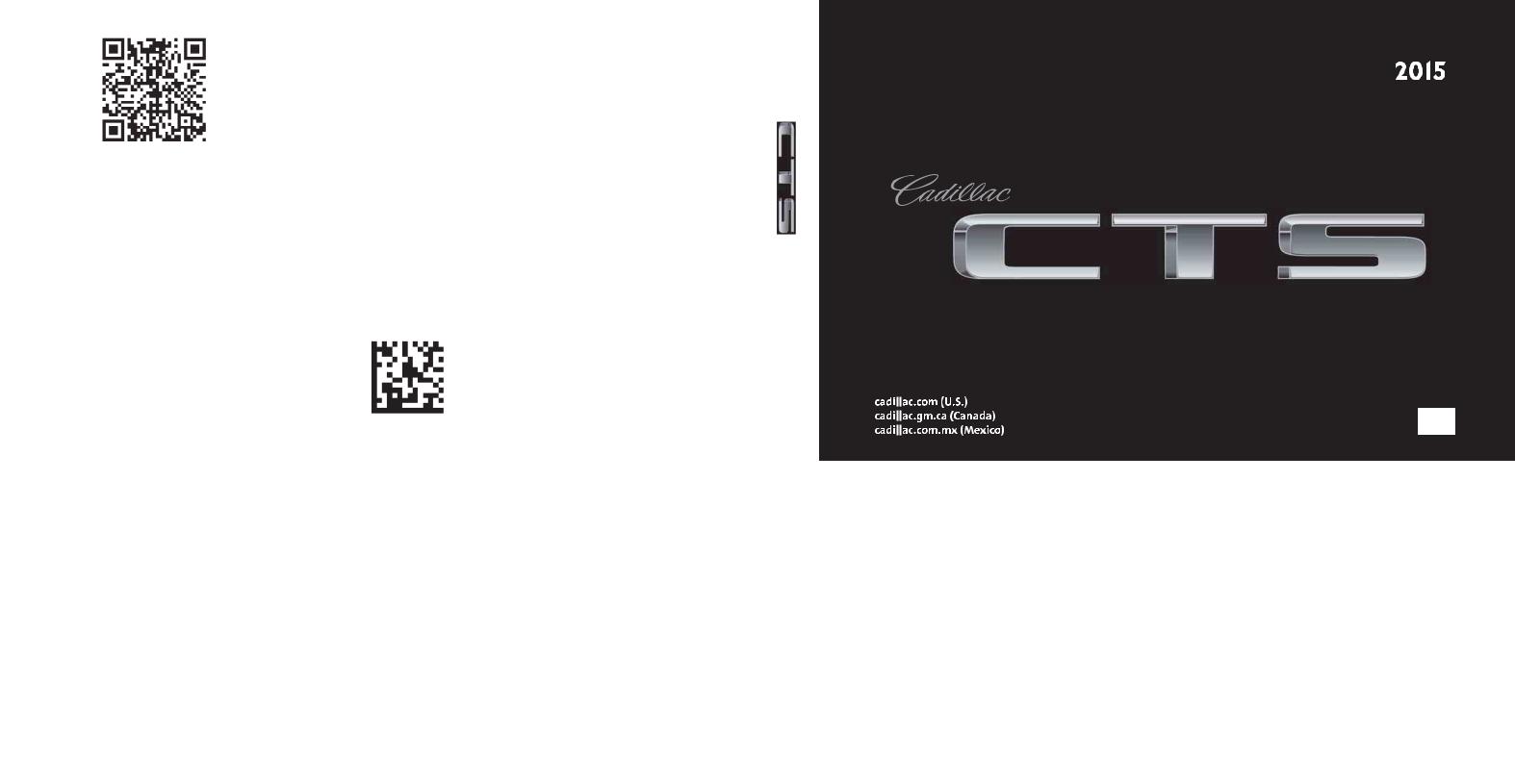

2015 Cadillac CTS Owner Manual M
In Brief . . . . . . . . . . . . . . . . . . . . . . . . 1-1
Instrument Panel . . . . . . . . . . . . . . 1-2
Initial Drive Information . . . . . . . . 1-4
Vehicle Features . . . . . . . . . . . . . 1-15
Performance and
Maintenance . . . . . . . . . . . . . . . . 1-20
Keys, Doors, and
Windows . . . . . . . . . . . . . . . . . . . . 2-1
Keys and Locks . . . . . . . . . . . . . . . 2-1
Doors . . . . . . . . . . . . . . . . . . . . . . . . 2-14
Vehicle Security. . . . . . . . . . . . . . 2-16
Exterior Mirrors . . . . . . . . . . . . . . . 2-19
Interior Mirrors . . . . . . . . . . . . . . . . 2-21
Windows . . . . . . . . . . . . . . . . . . . . . 2-21
Roof . . . . . . . . . . . . . . . . . . . . . . . . . . 2-25
Seats and Restraints . . . . . . . . . 3-1
Head Restraints . . . . . . . . . . . . . . . 3-2
Front Seats . . . . . . . . . . . . . . . . . . . . 3-3
Rear Seats . . . . . . . . . . . . . . . . . . . 3-10
Safety Belts . . . . . . . . . . . . . . . . . . 3-13
Airbag System . . . . . . . . . . . . . . . . 3-22
Child Restraints . . . . . . . . . . . . . . 3-35
Storage . . . . . . . . . . . . . . . . . . . . . . . 4-1
Storage Compartments . . . . . . . . 4-1
Additional Storage Features . . . 4-3
Instruments and Controls . . . . 5-1
Controls . . . . . . . . . . . . . . . . . . . . . . . 5-2
Warning Lights, Gauges, and
Indicators . . . . . . . . . . . . . . . . . . . . 5-9
Information Displays . . . . . . . . . . 5-29
Vehicle Messages . . . . . . . . . . . . 5-36
Vehicle Personalization . . . . . . . 5-47
Universal Remote System . . . . 5-55
Lighting . . . . . . . . . . . . . . . . . . . . . . . 6-1
Exterior Lighting . . . . . . . . . . . . . . . 6-1
Interior Lighting . . . . . . . . . . . . . . . . 6-6
Lighting Features . . . . . . . . . . . . . . 6-7
Infotainment System . . . . . . . . . 7-1
Introduction . . . . . . . . . . . . . . . . . . . . 7-1
Climate Controls . . . . . . . . . . . . . 8-1
Climate Control Systems . . . . . . 8-1
Air Vents . . . . . . . . . . . . . . . . . . . . . . . 8-8
Maintenance . . . . . . . . . . . . . . . . . . . 8-9
Driving and Operating . . . . . . . . 9-1
Driving Information . . . . . . . . . . . . . 9-2
Starting and Operating . . . . . . . 9-15
Engine Exhaust . . . . . . . . . . . . . . 9-22
Automatic Transmission . . . . . . 9-23
Drive Systems . . . . . . . . . . . . . . . . 9-26
Brakes . . . . . . . . . . . . . . . . . . . . . . . 9-27
Ride Control Systems . . . . . . . . 9-30
Cruise Control . . . . . . . . . . . . . . . . 9-34
Driver Assistance Systems . . . 9-45
Fuel . . . . . . . . . . . . . . . . . . . . . . . . . . 9-61
Trailer Towing . . . . . . . . . . . . . . . . 9-65
Conversions and Add-Ons . . . 9-70
Vehicle Care . . . . . . . . . . . . . . . . . 10-1
General Information . . . . . . . . . . 10-2
Vehicle Checks . . . . . . . . . . . . . . . 10-3
Headlamp Aiming . . . . . . . . . . . 10-29
Bulb Replacement . . . . . . . . . . 10-29
Electrical System . . . . . . . . . . . . 10-31
Wheels and Tires . . . . . . . . . . . 10-40

2015 Cadillac CTS Owner Manual M
Jump Starting . . . . . . . . . . . . . . . 10-64
Towing the Vehicle . . . . . . . . . . 10-67
Appearance Care . . . . . . . . . . . 10-69
Service and Maintenance . . . 11-1
General Information . . . . . . . . . . 11-1
Cadillac Premium Care
Maintenance . . . . . . . . . . . . . . . . 11-3
Maintenance Schedule . . . . . . . 11-3
Special Application
Services . . . . . . . . . . . . . . . . . . . . 11-9
Additional Maintenance
and Care . . . . . . . . . . . . . . . . . . . 11-10
Recommended Fluids,
Lubricants, and Parts . . . . . . 11-13
Maintenance Records . . . . . . . 11-16
Technical Data . . . . . . . . . . . . . . . 12-1
Vehicle Identification . . . . . . . . . 12-1
Vehicle Data . . . . . . . . . . . . . . . . . . 12-2
Customer Information . . . . . . . 13-1
Customer Information . . . . . . . . 13-1
Reporting Safety Defects . . . . 13-12
Vehicle Data Recording and
Privacy. . . . . . . . . . . . . . . . . . . . 13-14
OnStar . . . . . . . . . . . . . . . . . . . . . . . 14-1
OnStar Overview. . . . . . . . . . . . . 14-1
OnStar Services . . . . . . . . . . . . . . 14-2
OnStar Additional
Information . . . . . . . . . . . . . . . . . . 14-6
Index . . . . . . . . . . . . . . . . . . . . . i-1
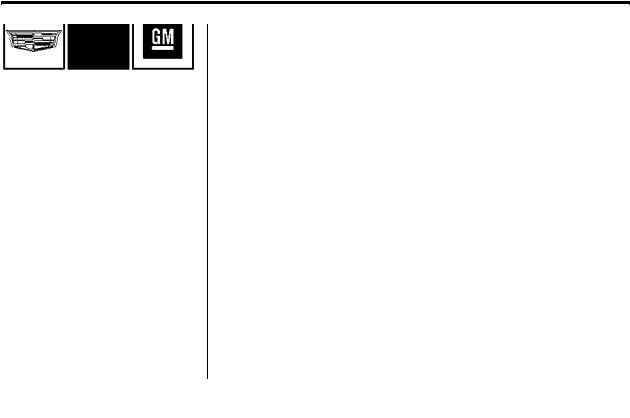
Introduction iii
The names, logos, emblems, slogans, vehicle model names, and vehicle body designs appearing in this manual including, but not limited to, GM, the GM logo, CADILLAC, the CADILLAC Emblem, and CTS are trademarks and/or service marks of General Motors LLC, its subsidiaries, affiliates, or licensors.
For vehicles first sold in Canada, substitute the name “General Motors of Canada Limited” for Cadillac Motor Car Division wherever it appears in this manual.
This manual describes features that may or may not be on the vehicle because of optional equipment that was not purchased on the vehicle, model variants, country specifications, features/applications that may not be available in your region, or changes subsequent to the printing of this owner manual.
Refer to the purchase documentation relating to your specific vehicle to confirm the features.
Keep this manual in the vehicle for quick reference.
Canadian Vehicle Owners
Propriétaires Canadiens
A French language manual can be obtained from your dealer, at www.helminc.com, or from:
On peut obtenir un exemplaire de ce guide en français auprès du concessionnaire ou à l'adresse savant:
Helm, Incorporated
Attention: Customer Service
47911 Halyard Drive
Plymouth, MI 48170
Using this Manual
To quickly locate information about the vehicle, use the Index in the back of the manual. It is an alphabetical list of what is in the manual and the page number where it can be found.
Litho in U.S.A. |
© 2014 General Motors LLC. All Rights Reserved. |
Part No. 22866698 A First Printing |
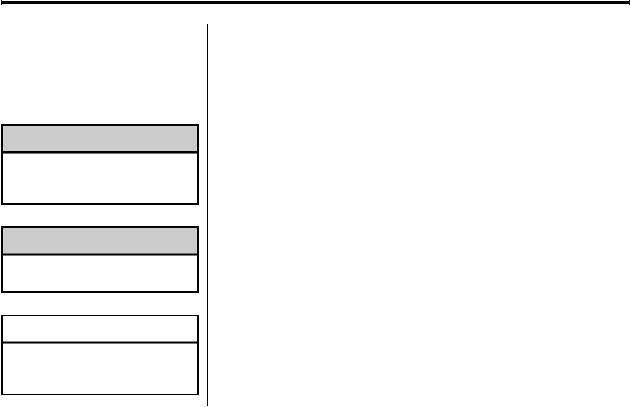
iv Introduction
Danger, Warnings, and
Cautions
Warning messages found on vehicle labels and in this manual describe hazards and what to do to avoid or reduce them.
{Danger
Danger indicates a hazard with a high level of risk which will result in serious injury or death.
{Warning
Warning indicates a hazard that could result in injury or death.
{Caution
Caution indicates a hazard that could result in property or vehicle damage.
A circle with a slash through it is a safety symbol which means “Do Not,” “Do not do this,” or “Do not let this happen.”
Symbols
The vehicle has components and labels that use symbols instead of text. Symbols are shown along with the text describing the operation or information relating to a specific component, control, message, gauge, or indicator.
M : This symbol is shown when you need to see your owner manual for additional instructions or information.
* : This symbol is shown when you need to see a service manual for additional instructions or information.
Vehicle Symbol Chart
Here are some additional symbols that may be found on the vehicle and what they mean. For more information on the symbol, refer to the Index.
9 : Airbag Readiness Light
# : Air Conditioning
! : Antilock Brake System (ABS)
g : Audio Steering Wheel Controls or OnStar® (if equipped)
$ : Brake System Warning Light
" : Charging System
I : Cruise Control
B : Engine Coolant Temperature
O : Exterior Lamps
. : Fuel Gauge
+ : Fuses
3 : Headlamp High/Low-Beam Changer
( : Heated Steering Wheel

Introduction v
j : LATCH System Child
Restraints
* : Malfunction Indicator Lamp
: : Oil Pressure
O : Power
/ : Remote Vehicle Start
> : Safety Belt Reminders
7 : Tire Pressure Monitor
d : Traction Control/StabiliTrak®
M : Windshield Washer Fluid

vi Introduction
2 NOTES

In Brief |
1-1 |
In Brief
Instrument Panel
Instrument Panel . . . . . . . . . . . . . . 1-2
Initial Drive Information
Initial Drive Information . . . . . . . . 1-4
Remote Keyless Entry (RKE)
System . . . . . . . . . . . . . . . . . . . . . . 1-4
Remote Vehicle Start . . . . . . . . . 1-5
Door Locks . . . . . . . . . . . . . . . . . . . 1-5
Trunk . . . . . . . . . . . . . . . . . . . . . . . . . 1-6
Windows . . . . . . . . . . . . . . . . . . . . . . 1-6
Seat Adjustment . . . . . . . . . . . . . . 1-7
Memory Features . . . . . . . . . . . . . 1-8
Heated and Ventilated
Seats . . . . . . . . . . . . . . . . . . . . . . . . 1-8
Head Restraint Adjustment . . . . 1-9
Safety Belts . . . . . . . . . . . . . . . . . . . 1-9
Passenger Sensing
System . . . . . . . . . . . . . . . . . . . . . 1-10
Mirror Adjustment . . . . . . . . . . . . 1-10
Steering Wheel
Adjustment . . . . . . . . . . . . . . . . . 1-11
Interior Lighting . . . . . . . . . . . . . . 1-11
Exterior Lighting . . . . . . . . . . . . . 1-12
Windshield Wiper/Washer . . . . 1-13
Climate Controls . . . . . . . . . . . . . 1-14
Transmission . . . . . . . . . . . . . . . . 1-15
Vehicle Features
Infotainment System . . . . . . . . . 1-15
Steering Wheel Controls . . . . . 1-15
Cruise Control . . . . . . . . . . . . . . . 1-15
Driver Information
Center (DIC) . . . . . . . . . . . . . . . 1-16
Forward Collision Alert (FCA)
System . . . . . . . . . . . . . . . . . . . . . 1-16
Lane Keep Assist (LKA) . . . . . 1-16
Lane Change Alert (LCA) . . . . 1-17
Rear Vision
Camera (RVC) . . . . . . . . . . . . . 1-17
Rear Cross Traffic Alert
(RCTA) System . . . . . . . . . . . . 1-17
Parking Assist . . . . . . . . . . . . . . . 1-17
Automatic Parking
Assist (APA) . . . . . . . . . . . . . . . . 1-17
Rear Automatic Braking (RAB)
System . . . . . . . . . . . . . . . . . . . . . 1-18
Active Emergency Braking
System . . . . . . . . . . . . . . . . . . . . . 1-18
Power Outlets . . . . . . . . . . . . . . . 1-18
Universal Remote System . . . 1-19
Sunroof . . . . . . . . . . . . . . . . . . . . . . 1-19
Performance and Maintenance
Traction Control/Electronic Stability Control . . . . . . . . . . . . 1-20
Tire Pressure Monitor . . . . . . . . 1-21 Engine Oil Life System . . . . . . 1-21 Driving for Better Fuel
Economy . . . . . . . . . . . . . . . . . . . 1-22
Roadside Service . . . . . . . . . . . . 1-22 OnStar® . . . . . . . . . . . . . . . . . . . . . 1-22
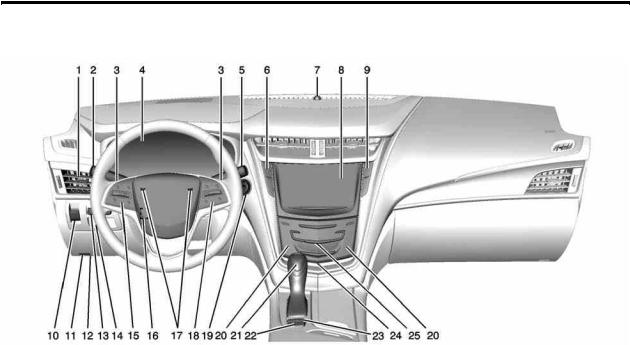
1-2 In Brief
Instrument Panel

In Brief |
1-3 |
1.Air Vents on page 8-8.
2.Turn Signal Lever. See Turn and Lane-Change Signals on
page 6-5.
3.Manual Mode on page 9-25 (If Equipped).
4.Instrument Cluster on page 5-10.
5.Windshield Wiper/Washer on page 5-3.
6.Hazard Warning Flashers on page 6-5.
Lane Keep Assist (LKA) on page 9-59 (If Equipped).
7.Light Sensor (If Equipped). See
Automatic Headlamp System on page 6-4.
Solar Sensor. See Dual Automatic Climate Control System on page 8-1.
8.Infotainment on page 7-1.
9.Glove Box Button. See Glove Box on page 4-2.
Automatic Parking Assist (If Equipped). See Assistance Systems for Parking or Backing on page 9-46.
Parking Assist Button. See
Assistance Systems for Parking or Backing on page 9-46.
10.Parking Brake Release Switch. See Electric Parking Brake on page 9-28.
11.Hood Release. See Hood on page 10-4.
12.Data Link Connector (DLC) (Out of View). See Malfunction Indicator Lamp on page 5-19.
13.Head-Up Display (HUD) on page 5-32 (If Equipped).
14.Instrument Panel Illumination Control on page 6-6.
15.Cruise Control on page 9-34 (If Equipped).
Adaptive Cruise Control on page 9-37 (If Equipped).
Forward Collision Alert (FCA) System on page 9-52 (If Equipped).
Heated Steering Wheel on page 5-3 (If Equipped).
16.Steering Wheel Adjustment on page 5-2.
17.Horn on page 5-3.
18.Steering Wheel Controls on page 5-3.
Driver Information Center (DIC) Controls. See Driver Information Center (DIC) on page 5-29.
19.ENGINE START/STOP Button. See Ignition Positions on page 9-16.
20.Heated and Ventilated Front Seats on page 3-8 (If Equipped).
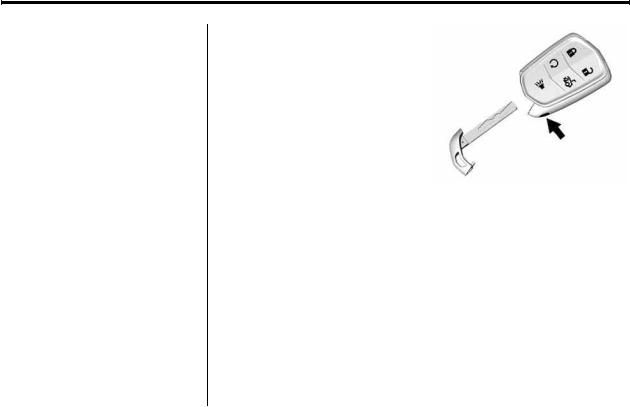
1-4 In Brief
21.Shift Lever. See Automatic Transmission on page 9-23.
Manual Mode Button. See
Automatic Transmission on page 9-23.
22.MODE Switch. See Driver Mode Control on page 9-31.
23.Traction Control/Electronic Stability Control on page 9-30.
24.Instrument Panel Storage on page 4-1.
25.Dual Automatic Climate Control System on page 8-1.
Initial Drive
Information
This section provides a brief overview about some of the important features that may or may not be on your specific vehicle.
For more detailed information, refer to each of the features which can be found later in this owner manual.
Remote Keyless Entry
(RKE) System
The RKE transmitter may work up to 60 m (197 ft) away.
Press the button to remove the key. The key can be used for all locks.
Press K to unlock the driver door or all doors.
Press Q to lock all doors.
Lock and unlock feedback can be personalized. See Vehicle Personalization on page 5-47.
Press X twice quickly to release the trunk.
Press 7 and release to initiate vehicle locator.

In Brief |
1-5 |
Press and hold 7 for more than three seconds to sound the panic alarm.
Press 7 again to cancel the panic alarm.
/ Press and release Q and then press and hold / for at least four seconds to start the engine from outside the vehicle using the RKE transmitter.
See Keys on page 2-1 and Remote Keyless Entry (RKE) System Operation on page 2-3.
Remote Vehicle Start
The engine can be started from outside of the vehicle.
Starting the Vehicle
1.Press and release Q on the transmitter.
2.Immediately after completing Step 1, press and hold / for at least four seconds or until the turn signal lamps flash.
3.Press the brake pedal and select ON/RUN/START ignition mode to drive the vehicle.
When the vehicle starts, the parking lamps will turn on and remain on as long as the engine is running. The doors will be locked and the climate control system may come on.
The engine will continue to run for 10 minutes. Repeat the steps for a 10-minute time extension. Remote start can be extended only once.
Canceling a Remote Start
To cancel a remote start do any of the following:
.Press and hold / until the parking lamps turn off.
.Turn on the hazard warning flashers.
.Turn the vehicle on and then off.
See Remote Vehicle Start on page 2-9.
Door Locks
Keyless Access
Press the button on the door handle and pull the handle when the Remote Keyless Entry (RKE) transmitter is within range. See
Remote Keyless Entry (RKE) System Operation on page 2-3.
Manual Operation
From outside, use the key in the driver door. The key cylinder is covered by a cap. See Door Locks on page 2-11.
From the inside rear doors, push down on the door lock knob on top of the door. To unlock a door, pull once on the door handle to unlock it, and again to open it.
Power Door Locks
From outside, press Q or K on the RKE transmitter. See Remote Keyless Entry (RKE) System Operation on page 2-3.
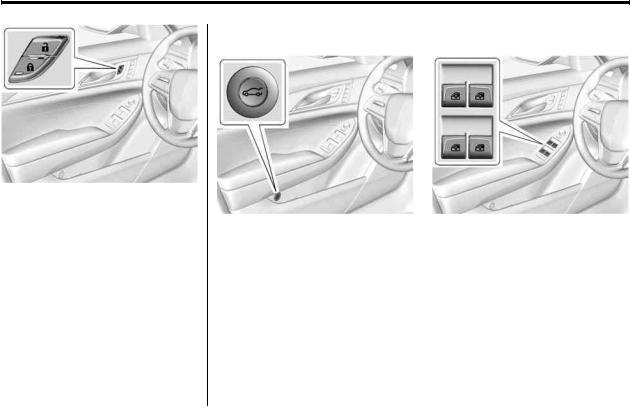
1-6 In Brief
From inside, press Q or K. The indicator light in the switch will illuminate when locked. See Power Door Locks on page 2-12.
Trunk |
Windows |
To open the trunk, press |on the
driver door, press X twice quickly on the Remote Keyless Entry (RKE) transmitter, or press the touch pad on the rear of the vehicle after unlocking all doors.
If equipped with Keyless Access, press the touch pad on the rear of the trunk above the license plate when the RKE transmitter is in range. See Remote Keyless Entry (RKE) System Operation on
page 2-3 and Trunk on page 2-14.
The driver power window switches control all the windows. The passenger switch only controls that window.
Press the switch down to lower the window. Pull the switch up to raise it. See Power Windows on
page 2-21.
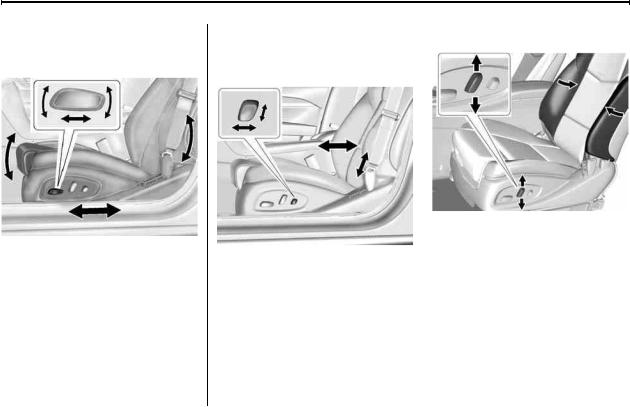
In Brief |
1-7 |
Seat Adjustment
Power Seats
To adjust the seat:
.Move the seat forward or rearward by sliding the control forward or rearward.
.Raise or lower the seat by moving the rear of the control up or down.
.If equipped, raise or lower the front part of the seat cushion by moving the front of the control up or down.
See Power Seat Adjustment on page 3-3.
Lumbar Adjustment
If equipped, to adjust the lumbar support, press and hold the control forward or rearward or up and down.
See Lumbar Adjustment on page 3-4.
Bolster Adjustment
If equipped, to adjust the bolster support, press and hold the recliner control up and down.
See Lumbar Adjustment on page 3-4.
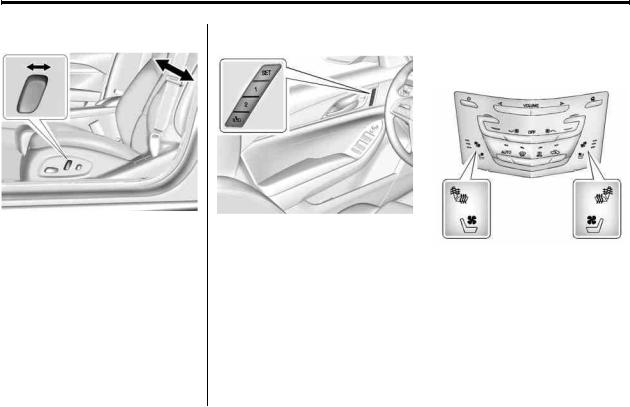
1-8 In Brief
Reclining Seatbacks |
Memory Features |
Heated and Ventilated |
|
|
Seats |
|
|
Front Seats |
To adjust the seatback:
.Tilt the top of the control rearward to recline.
.Tilt the top of the control forward to raise.
See Reclining Seatbacks on page 3-5.
The SET, "1," "2," and B (Exit) buttons on the driver door are used to manually save and recall memory settings for the driver seat, outside mirrors, and power tilt and telescoping steering column (if equipped).
See Memory Seats on page 3-6 and Vehicle Personalization on
page 5-47.
Front Seats
If equipped, the buttons are near the climate controls on the center stack. To operate, the ignition must be in ON/RUN/START.
Press J or z to heat the driver or passenger seat cushion and seatback.
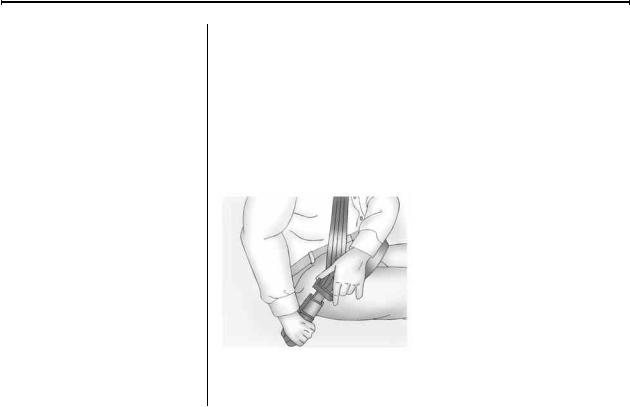
In Brief |
1-9 |
Press Cor { to ventilate the driver or passenger seat. A ventilated seat has a fan that pulls or pushes air through the seat. The air is not cooled.
Press the button once for the highest setting. With each press of the button, the seat will change to the next lower setting, and then to the off setting. The indicator lights next to the buttons indicate three for the highest setting and one for the lowest. If the front heated seats are on high, the level may automatically be lowered after approximately
30 minutes.
See Heated and Ventilated Front Seats on page 3-8.
Head Restraint
Adjustment
To achieve a comfortable seating position, change the seatback recline angle as little as necessary while keeping the seat and the head restraint height in the proper position.
See Head Restraints on page 3-2 and Power Seat Adjustment on page 3-3.
Safety Belts
Refer to the following sections for important information on how to use safety belts properly:
.Safety Belts on page 3-13.
.How to Wear Safety Belts Properly on page 3-14.
.Lap-Shoulder Belt on page 3-15.
.Lower Anchors and Tethers for Children (LATCH System) on page 3-43.
Do not drive until the head restraints for all occupants are installed and adjusted properly.
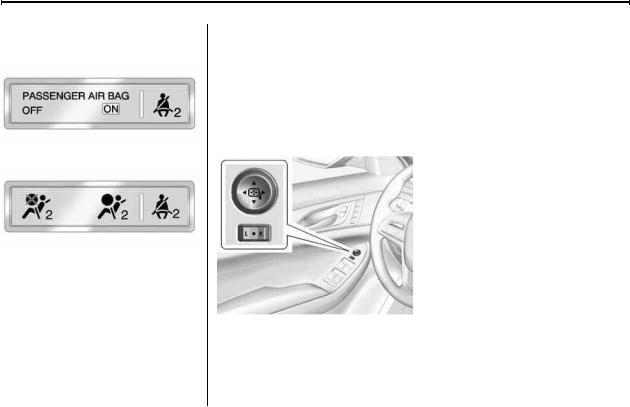
1-10 |
In Brief |
Passenger Sensing
System
United States
Canada and Mexico
The passenger sensing system will turn off the front outboard passenger frontal airbag and knee airbag under certain conditions. No other airbag is affected by the passenger sensing system. See
Passenger Sensing System on page 3-28.
The passenger airbag status indicator lights on the overhead console are visible when the vehicle is started. See Passenger Airbag Status Indicator on page 5-18.
Mirror Adjustment
Exterior
Controls for the outside power mirrors are on the driver door.
To adjust each mirror:
1.Press (L) or (R) to select the driver or passenger side mirror.
2.Press the arrows on the control pad to move the mirror up, down, right, or left.
3.Adjust each mirror so that a little of the vehicle and the area behind it can be seen.
4.Return the selector switch to the center position.
See Power Mirrors on page 2-20.
Interior
The vehicle has an automatic dimming inside rearview mirror. Automatic dimming reduces the glare of headlamps from behind. The dimming feature comes on when the vehicle is started.
See Automatic Dimming Rearview Mirror on page 2-21.
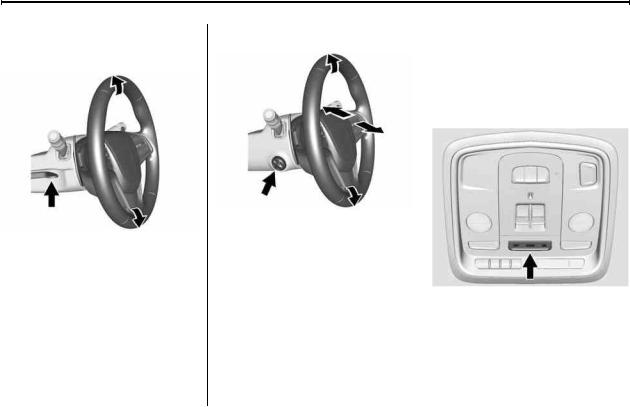
In Brief |
1-11 |
Steering Wheel
Adjustment
To adjust the steering wheel:
1.Pull the lever down.
2.Move the steering wheel up or down.
3.Pull or push the steering wheel closer or away from you.
4.Pull the lever up to lock the steering wheel in place.
Power Tilt and Telescoping Wheel
If equipped, the control is on the left side of the steering column.
.Push the control up or down to tilt the steering wheel up
or down.
.Push the control forward or rearward to move the steering wheel toward the front or rear of the vehicle.
Do not adjust the steering wheel while driving.
To set the power tilt wheel memory position, see Memory Seats on page 3-6.
Interior Lighting
Dome Lamp
To change the dome lamp settings, press the following:
OFF: Turns the lamp off, even when a door is open.
DOOR: The lamp comes on when a door is opened.
ON: Turns the lamp on.
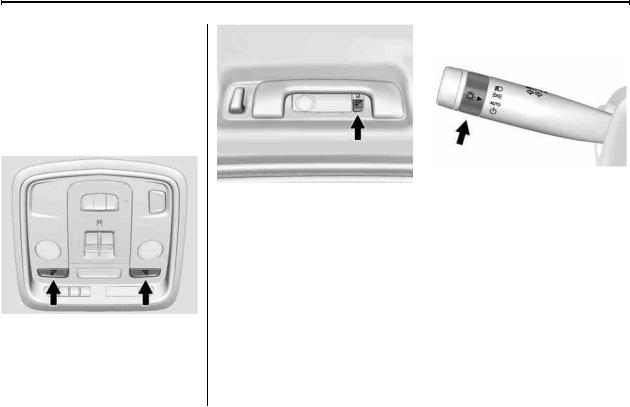
1-12 |
In Brief |
Reading Lamps
There are front and rear reading lamps on the overhead console and over the rear passenger doors. These lamps come on when any door is opened.
To manually turn the reading lamps on or off:
Press m or n next to each overhead console reading lamp.
Press the button next to each rear passenger reading lamp.
For more information on interior lighting, see Instrument Panel Illumination Control on page 6-6.
Exterior Lighting
There are four positions:
O : Turns off the exterior lamps. The knob returns to the AUTO position after it is released. Turn to O again to reactivate the AUTO mode. In Canada, the headlamps will automatically reactivate when the vehicle is shifted out of P (Park).
AUTO: Automatically turns the exterior lamps on and off, depending on outside lighting.
; : Turns on the parking lamps including all lamps, except the headlamps.
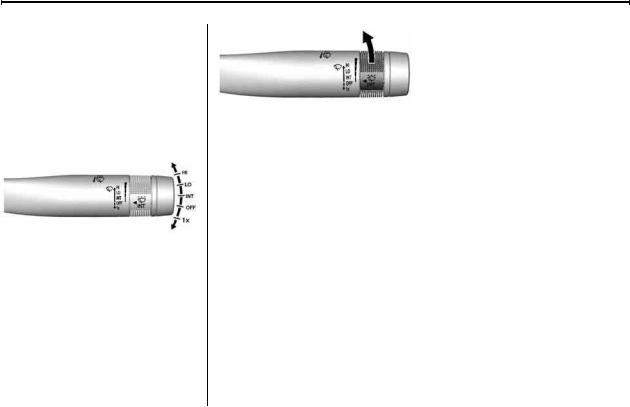
In Brief |
1-13 |
5 : Turns on the headlamps together with the parking lamps and instrument panel lights.
See Exterior Lamp Controls on page 6-1 and Daytime Running Lamps (DRL) on page 6-4.
Windshield Wiper/Washer
With the ignition in ACC/ ACCESSORY or ON/RUN/START, move the lever to select the wiper speed.
HI: Use for fast wipes.
LO: Use for slow wipes.
INT: Move the windshield wiper lever to INT. Turn the x INT band up for more frequent wipes or down for less frequent wipes. If equipped with Rainsense, turn the x INT band to adjust the sensitivity. To turn the Rainsense feature on or off, see “Rain Sense Wipers” under Vehicle Personalization on page 5-47.
OFF: Use to turn the wipers off.
1X : For a single wipe, briefly move the lever down. For several wipes, hold the lever down.
n L : Pull the lever toward you to spray windshield washer fluid and activate the wipers.
See Windshield Wiper/Washer on page 5-3.
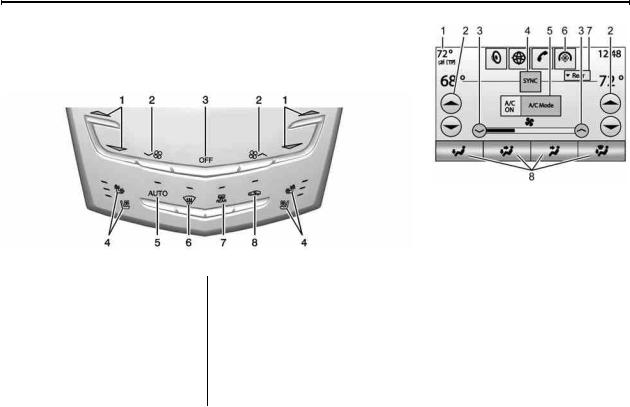
1-14 |
In Brief |
Climate Controls
The climate control buttons and the touch screen are used to adjust the heating, cooling, and ventilation.
|
|
Climate Control Buttons |
|
1. |
Driver and Passenger |
5. |
AUTO (Automatic Operation) |
|
Temperature Controls |
6. |
Defrost |
|
|
||
2. |
Fan Control |
7. |
Rear Window Defogger |
|
|
||
3. |
OFF (Fan) |
8. |
Recirculation |
|
|
||
4.Driver and Passenger Heated and Ventilated Seats
Climate Touch Screen Controls
1.Outside Temperature Display
2.Driver and Passenger Temperature Controls
3.Fan Control
4.SYNC (Synchronized Temperature)
5.A/C Mode (Air Conditioning)
6.Climate Control Selection (Application Tray Button)
7.Rear (Rear Climate Control Touch Screen)
8.Air Delivery Mode Control
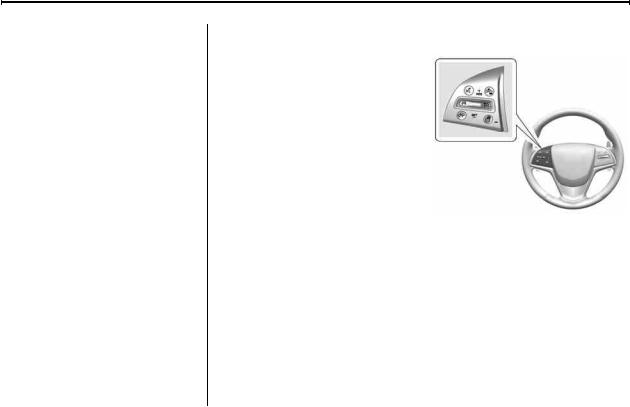
In Brief |
1-15 |
See Dual Automatic Climate Control System on page 8-1 and Rear Climate Control System on page 8-6
(if equipped).
Transmission
Tap Shift
If equipped, permanent Tap Shift Mode may be entered with the shift lever in D (Drive), by pressing the M (Manual Mode) button on the top of the shift lever.
Temporary Tap Shift Mode may be entered while in D (Drive) using the tap shift controls on the back of the steering wheel.
See Manual Mode on page 9-25.
Vehicle Features
Infotainment System
See the infotainment manual for information on the radio, audio players, phone, navigation system, and voice or speech recognition. It also includes information on settings.
Steering Wheel Controls
The infotainment system can be operated by using the steering wheel controls. See "Steering Wheel Controls" in the infotainment manual.
Cruise Control
J : Press to turn the system on and off. A white indicator appears in the instrument cluster when cruise is turned on.
+RES: If there is a set speed in memory, press the control up briefly to resume to that speed or press and hold to accelerate. If the cruise control is already active, use to increase vehicle speed. To increase speed by 1 km/h (1 mph), press +RES up to the first detent. To
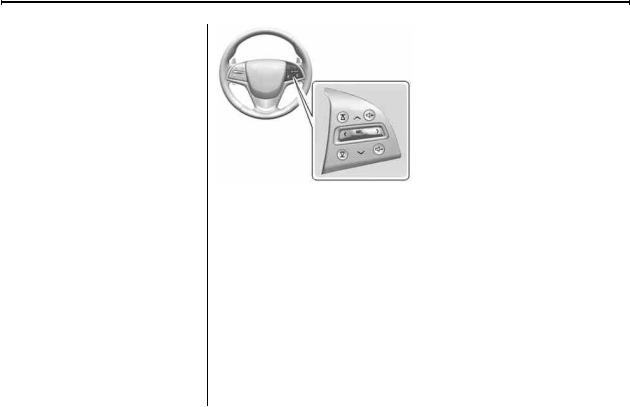
1-16 |
In Brief |
increase speed to the next 5 km/h (5 mph) mark on the speedometer, press +RES up to the second detent.
SET−: Press the control down briefly to set the speed and activate cruise control. If cruise control is already active, use to decrease vehicle speed. To decrease speed by 1 km/h (1 mph), press SET− down to the first detent. To decrease speed to the next 5 km/h (5 mph) mark on the speedometer, press SET− down to the second detent.
* : Press to disengage cruise control without erasing the set speed from memory.
See Cruise Control on page 9-34 or Adaptive Cruise Control on
page 9-37 (if equipped).
Driver Information
Center (DIC)
The DIC display is in the instrument cluster. It shows the status of many vehicle systems.
y or z : Press to move up or down in a list.
S or T: Press to move between the interactive display zones in the
cluster. Press S to go back to the previous menu.
SEL: Press to open a menu or select a menu item. Press and hold to reset values on certain screens.
See Driver Information Center (DIC) on page 5-29.
Forward Collision Alert
(FCA) System
If equipped, FCA may help avoid or reduce the harm caused by front-end crashes. FCA provides a
green indicator, V, when a vehicle is detected ahead. This indicator displays amber if you follow a vehicle much too closely. When approaching a vehicle ahead too quickly, FCA provides a flashing red alert on the windshield and rapidly beeps or pulses the driver seat.
See Forward Collision Alert (FCA) System on page 9-52.
Lane Keep Assist (LKA)
If equipped, LKA may help avoid crashes due to unintentional lane departures. It may assist by gently turning the steering wheel if the vehicle approaches a detected lane marking without using a turn signal in that direction. It may also provide a Lane Departure Warning (LDW) alert as the lane marking is crossed.

In Brief |
1-17 |
The system will not assist or alert if it detects that you are actively steering. Override LKA by turning the steering wheel. LKA uses a camera to detect lane markings between 60 km/h (37 mph) and 180 km/h (112 mph).
See Lane Keep Assist (LKA) on page 9-59.
Lane Change Alert (LCA)
If equipped, the LCA system is a lane-changing aid that assists drivers with avoiding lane change crashes that occur with vehicles in the side blind zone (or spot) areas or with vehicles rapidly approaching these areas from behind. The LCA warning display will light up in the corresponding outside side mirror and will flash if the turn signal is on. The Side Blind Zone Alert (SBZA) system is included as part of the LCA system.
See Side Blind Zone Alert (SBZA) on page 9-56 and Lane Change Alert on page 9-56.
Rear Vision
Camera (RVC)
If equipped, RVC displays a view of the area behind the vehicle on the center stack display when the vehicle is shifted into R (Reverse) to aid with parking and low-speed backing maneuvers.
See Assistance Systems for Parking or Backing on page 9-46.
Rear Cross Traffic Alert
(RCTA) System
If equipped, when backing, the RCTA system uses a triangle with an arrow displayed on the RVC screen to warn of traffic behind your vehicle that may cross your vehicle's path. In addition, beeps will sound, or the driver seat will pulse.
See Assistance Systems for Parking or Backing on page 9-46
Parking Assist
If equipped, Rear Parking
Assist (RPA) uses sensors on the rear bumper to assist with parking and avoiding objects while in
R (Reverse). It operates at speeds less than 8 km/h (5 mph). RPA may display a warning triangle on the Rear Vision Camera screen and a graphic on the instrument cluster to provide the object distance. In addition, multiple beeps or seat pulses may occur if very close to an object.
The vehicle may also have the Front Parking Assist system.
See Assistance Systems for Parking or Backing on page 9-46.
Automatic Parking
Assist (APA)
If equipped, the APA system helps to search for and maneuver the vehicle into parallel or perpendicular parking spots using automatic steering, DIC displays, and beeps.

1-18 |
In Brief |
When the vehicle speed is below 30 km/h (18 mph), press the APA
button, O, to enable the system.
See “Automatic Parking Assist (APA)” under Assistance Systems for Parking or Backing on
page 9-46.
Rear Automatic Braking
(RAB) System
If the vehicle has Adaptive Cruise Control (ACC) it also has the Rear Automatic Braking (RAB) system, which is designed to help avoid or reduce the harm caused by backing crashes. If the system detects the vehicle is backing too fast to avoid a crash with a detected object behind your vehicle in your path, it may automatically brake hard to a stop.
See Assistance Systems for Parking or Backing on page 9-46
Active Emergency
Braking System
If the vehicle has Adaptive Cruise Control (ACC) it also has the Active Emergency Braking System, which includes Intelligent Brake
Assist (IBA) and the Automatic Collision Preparation (ACP) System. These systems can provide a boost to braking or automatically brake the vehicle to help avoid or lessen the severity of crashes when driving in a forward gear.
See Active Emergency Braking System on page 9-54.
Power Outlets
Accessory power outlets can be used to plug in electrical equipment, such as a cell phone or MP3 player.
The vehicle has three 12-volt accessory power outlets:
.Inside the center console storage in front of the armrest cover.
.Inside the storage area under the armrest cover.
.On the rear of the center console, if equipped.
These outlets are powered while the vehicle is in ON/RUN/START or ACC/ACCESSORY mode, or until the driver door is opened within
10 minutes of turning off the vehicle.
Lift the cover to access the accessory power outlet.
See Power Outlets on page 5-6.
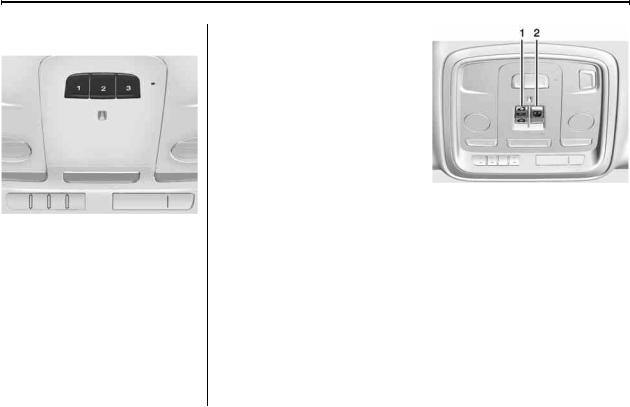
In Brief |
1-19 |
Universal Remote System
If equipped, this system provides a way to replace up to three remote control transmitters used to activate devices such as garage door openers, security systems, and home automation devices.
Read the instructions completely before attempting to program the Universal Remote system. Because of the steps involved, it may be helpful to have another person
available to assist you with programming the Universal Remote system.
See Universal Remote System on page 5-55.
Sunroof
If equipped, the sunroof will only operate when the ignition is in ON/ RUN or ACC/ACCESSORY,
or when Retained Accessory Power (RAP) is active. See Ignition Positions on page 9-16 and Retained Accessory Power (RAP) on page 9-19.
The driver side switch (1) operates the sunroof.
Vent: Press and release the front of the switch (1) to vent the sunroof. The sunshade will automatically open approximately 38 cm (15 in). Press and hold the rear of the switch (1) to close the sunroof vent.
Express Open/Express Close:
Press the front of the switch (1) a second time to express open the sunroof. Press the rear of the switch (1) to express close. To stop the sunroof partway, press the switch (1) again.

1-20 |
In Brief |
The passenger side switch (2) operates the sunshade. Press and release the front or rear of the switch (2) to express open or express close the sunshade. To stop the sunshade partway, press the switch (2) again.
See Sunroof on page 2-25.
Performance and
Maintenance
Traction Control/
Electronic Stability
Control
The Traction Control System (TCS) limits wheel spin. The system turns on automatically every time the vehicle is started.
StabiliTrak assists with directional control of the vehicle in difficult driving conditions. The system turns on automatically every time the vehicle is started.
.To turn off TCS, press and release the TCS/StabiliTrak
button Yon the center console. i illuminates in the instrument cluster. The appropriate DIC message is displayed. See Ride Control System Messages on page 5-43.
.Press the TCS/StabiliTrak button Yagain to turn traction control back on.
.To turn off both TCS and StabiliTrak, press and hold the TCS/StabiliTrak button Yon the center console until g and i illuminate in the instrument cluster. The appropriate DIC message displays. See Ride Control System Messages on page 5-43.
.Press the TCS/StabiliTrak button Yagain to turn on both systems.
See Traction Control/Electronic Stability Control on page 9-30.

In Brief |
1-21 |
Tire Pressure Monitor
This vehicle may have a Tire Pressure Monitor System (TPMS).
The low tire pressure warning light alerts to a significant loss in pressure of one of the vehicle's tires. If the warning light comes on, stop as soon as possible and inflate the tires to the recommended pressure shown on the Tire and Loading Information label. See
Vehicle Load Limits on page 9-11. The warning light will remain on until the tire pressure is corrected.
The low tire pressure warning light may come on in cool weather when the vehicle is first started, and then turn off as the vehicle is driven. This may be an early indicator that the
tire pressures are getting low and the tires need to be inflated to the proper pressure.
The TPMS does not replace normal monthly tire maintenance. Maintain the correct tire pressures.
See Tire Pressure Monitor System on page 10-51.
Engine Oil Life System
The engine oil life system calculates engine oil life based on vehicle use and displays the CHANGE ENGINE OIL SOON message when it is time to change the engine oil and filter.
The oil life system should be reset to 100% only following an oil change.
Resetting the Oil Life System
1.Using the DIC buttons, display REMAINING OIL LIFE on the DIC. See Driver Information Center (DIC) on page 5-29 and Engine Oil Messages on
page 5-39.
2.Press the SEL button and hold to clear the CHANGE ENGINE OIL SOON message and reset the oil life at 100%.
Be careful not to reset the oil life display accidentally at any time other than after the oil is changed. It cannot be reset accurately until the next oil change.
The oil life system can also be reset as follows:
1.Turn the ignition on with the engine off.
2.Fully press and release the accelerator pedal three times within five seconds.
If the CHANGE ENGINE OIL SOON message is not on, the system is reset.
See Engine Oil Life System on page 10-12.

1-22 |
In Brief |
Driving for Better Fuel Economy
Driving habits can affect fuel mileage. Here are some driving tips to get the best fuel economy possible.
.Avoid fast starts and accelerate smoothly.
.Brake gradually and avoid abrupt stops.
.Avoid idling the engine for long periods of time.
.When road and weather conditions are appropriate, use cruise control.
.Always follow posted speed limits or drive more slowly when conditions require.
.Keep vehicle tires properly inflated.
.Combine several trips into a single trip.
.Replace the vehicle's tires with the same TPC Spec number molded into the tire's sidewall near the size.
.Follow recommended scheduled maintenance.
Roadside Service
U.S.: 1-800-224-1400
Canada: 1-800-882-1112
TTY Users (U.S. Only): 1-888-889-2438
New Cadillac owners are automatically enrolled in the Roadside Service Program.
See Roadside Service on page 13-5.
OnStar®
This vehicle may be equipped with a comprehensive, in-vehicle system that can connect to a live OnStar Advisor for Emergency, Security, Navigation, Connection, and Diagnostic Services. OnStar services may require a paid subscription. See OnStar Overview on page 14-1.

Keys, Doors, and Windows 2-1
Keys, Doors, and
Windows
Keys and Locks
Keys . . . . . . . . . . . . . . . . . . . . . . . . . . 2-1
Remote Keyless Entry (RKE)
System . . . . . . . . . . . . . . . . . . . . . . 2-2
Remote Keyless Entry (RKE)
System Operation . . . . . . . . . . . 2-3
Remote Vehicle Start . . . . . . . . . 2-9
Door Locks . . . . . . . . . . . . . . . . . . 2-11
Power Door Locks . . . . . . . . . . . 2-12
Delayed Locking . . . . . . . . . . . . . 2-13
Automatic Door Locks . . . . . . . 2-13
Lockout Protection . . . . . . . . . . . 2-13
Safety Locks . . . . . . . . . . . . . . . . . 2-14
Doors
Trunk . . . . . . . . . . . . . . . . . . . . . . . . 2-14
Vehicle Security
Vehicle Security . . . . . . . . . . . . . . 2-16
Vehicle Alarm System . . . . . . . 2-16
Immobilizer . . . . . . . . . . . . . . . . . . 2-18
Immobilizer Operation . . . . . . . 2-18
Exterior Mirrors
Convex Mirrors . . . . . . . . . . . . . . 2-19
Power Mirrors . . . . . . . . . . . . . . . . 2-20
Folding Mirrors . . . . . . . . . . . . . . . 2-20
Heated Mirrors . . . . . . . . . . . . . . . 2-20
Reverse Tilt Mirrors . . . . . . . . . . 2-20
Interior Mirrors
Interior Rearview Mirrors . . . . . 2-21
Automatic Dimming Rearview
Mirror . . . . . . . . . . . . . . . . . . . . . . . 2-21
Windows
Windows . . . . . . . . . . . . . . . . . . . . . 2-21
Power Windows . . . . . . . . . . . . . 2-21
Sun Visors . . . . . . . . . . . . . . . . . . . 2-24
Rear Window Sunshade . . . . . 2-24
Roof
Sunroof . . . . . . . . . . . . . . . . . . . . . . 2-25
Keys and Locks
Keys
{Warning
Leaving children in a vehicle with a Remote Keyless Entry (RKE) transmitter is dangerous and children or others could be seriously injured or killed. They could operate the power windows or other controls or make the vehicle move. The windows will function with the RKE transmitter in the vehicle, and children or others could be caught in the path of a closing window. Do not leave children in a vehicle with an RKE transmitter.
